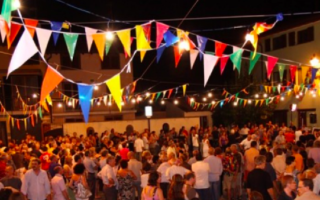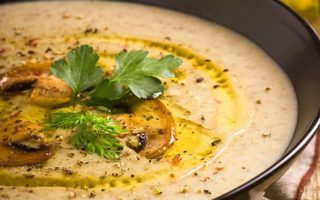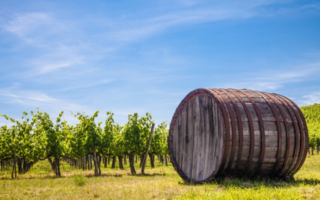Regions’ Greetings!
Christmas Food And Festive Traditions
From Around Italy
With the long nights setting in, the temperatures beginning to plummet, and Christmas lights transforming towns and cities worldwide into winter wonderlands, it’s beginning to look a lot like Christmas. It’ll soon be time to deck the halls and train the stomachs, especially here in Italy where the food-happy festive period runs from December 24th all the way through to January 6th.
This Christmas will see families the length and breadth of Italy come together from all over to eat, drink, and be merry. It goes without saying that the food will be plenty and the wine will be flowing. But what usually tops the tavola at a traditional Italian feast? The answer is a bit—or rather a lot—of everything. More than in the US and the UK, there’s considerable regional variation around what the Italians eat at natale: from antipasti and pasta dishes to seafood, meat, and sweet, sweet dolci.
But if there’s one thing that brings the country together, it’s the sheer quantity of the food on offer and the marathon duration of the meals. Given the pride of place Italians attach to their cuisine, this shouldn’t come as much of a surprise. What may come as a surprise, however, are some of the more traditional culinary customs that make an Italian Christmas it so distinctive.
On la vigilia (the Italian Christmas Eve), for example, Italians countrywide abstain from eating meat and eat only seafood. This is especially the case with the coastal regions in the South, where families traditionally serve up enough fish to feed the five thousand five times over. Or rather seven times: for thanks to a twentieth-century American rekindling of the tradition, the Christmas Eve Feast of the Seven Fishes—in which seven seafood dishes are served up—has once again become commonplace.
 |
| “Feast of the Seven Fishes”. Wooder Ice |
The richness of Italian culinary culture is characterised by its many regional dishes. While all twenty regions have something unique and well worth trying, however, here at Roman Candle Tours we’re going to take you through some of the best seasonal offerings to try during your Christmas in Italy from the North (Milan, Turin, Venice, Verona), the Centre (Florence, Siena, Bologna, Rome), and the South (Naples, Palermo, and the regions of Calabria and Puglia).
The North of Italy
As the people who brought us Gorgonzola, saffron risotto, and the aperitivo, it goes without saying that the Milanese have done much to enrich our culinary Christmas traditions. But of all the wonderful festive food they’ve given us, it’s probably fair to say that their most popular contribution is the sweet Christmas cake loved the world over: panettone.
Tradition has it that the panettonedates back to the fifteenth century and was born out of a young man’s love for a beautiful baker’s daughter. Because of her father’s profession, he decided that his best bet of winning her over was to turn up at dad’s bakery with a moist, raisin-filled sweet bread—thus very literally demonstrating his suitability as a breadwinner. And as the baker was called Toni, the young suitor called his cake the pan de toni (Tony’s bread). The absolute sycophant.
So much for legend, but the panettoneprototype as we know it was actually invented in 1919 by pastry chef—and (naturally) future finance minister—Angelo Motta. Returning from the Great War, Motta decided that the country could do with something sweet, and got to work on his eponymous “Motta” cake. But Motta wasn’t the only one hard at work inventing a sweet, candied fruit-filled bread.
 |
| Panettone. Wikipedia |
His rival panettone maker (only in Italy could such a thing exist), Gioacchino Alemagna, would later adapt the original recipe and give the fruity beast the name it has today. To give panettone its soft and fluffy texture, it needs to be left to rise and fall several times, meaning it takes a fair while to bake. But unless you’re a budding baker, you’re best off saving your energy and instead going for one of the best panettonebrands out there, increasingly available the world over.
Head a hundred miles east from Milan and you come to Verona—home to Romeo & Juliet as well as the infinitely more joy-bringing celebratory export: pandoro. Not to be confused with Pandora (though as with Pandora, once the box is opened sinful gluttony is sure to follow), pandorois a sweet, golden bread shaped like an eight-point star.
Dusted with vanilla flavoured icing sugar, the aesthetic idea behind the pandoro is that it should resemble the snow-capped Alps at Christmastime. When you buy a pandoro it usually comes with a pack of icing sugar to sprinkle over it yourself. While you can do this straightaway, on the recommendation of one of my Italian students try putting the pandoro in the oven for a few minutes first. With the freshly baked smell and extra rich taste this will produce, I guarantee you won’t regret it.
 |
| Pandoro. Italoamericano.org |
Christmastime is indeed when Italians eat panettone and pandoro in industrial quantities, munching their way through at least 117 million cakes annually along with countless other Christmas Italian desserts. But as much as sweet offerings, savoury dishes play an equally (if not more) important role on any Italian dinner table. Ricotta Spinach Manicottiis a popular first course across most of the northern regions, while Austria’s clear influence on the culinary culture of Veneto shines through with the classic brovada e muset (turnips and sausages).
Central Italy
After Milan and Verona, Tuscany probably comes out top for its sweet inventions. In particular, the steep, sleepy medieval city of Siena is famous for its panforte: a sweet cake that dates back to the thirteenth century (making it as old as the city’s university). Panforte might literally mean “strong bread”, but it has nothing of bread’s traditional savoury taste. Instead, panforte is a sugary, nutty composite of honey and dried fruits, sometimes infused with chocolate; often wrapped in rice paper.
If almonds float your boat, you’d also do well to try out ricciarelli. Legend has it that these deliciousChristmas cookieswere invented a century after panforteby the Volterran aristocrat Ricciardetto della Gherardesca. Shortly after his return from slaughtering Saracens in the Holy Land, Ricciardetto decided to capitalise on his time away from crusading to pursue his culinary interests. And so mixing almonds, sugar, honey, and egg white, he created a macaroon type biscuit (follow this link for one ofthe best cookie recipesfor ricciarelli) still typically consumed at Christmas with a glass of sweet vin santo.
 |
| Ricciarelli. The Telegraph |
Sweet treats are only half the story when it comes to Christmas food in Central Italy. The nearest thing there is to a lamb dinner actually comes from the Roman region of Lazio. When in Rome, be sure to try out the abbacchio al forno con patate (lamb done in the oven with potatoes). Be aware, however, that it’s a salty affair: traditionally, the lamb is braised in garlic, balsamic vinegar, and anchovies, creating a taste that’s a far cry from our classic mint sauce combo.
 |
| Abbacchio al forno con patate. Philip Kowalik |
Should you find yourself in Bologna (and trust me when I say there are worse places to end up around Christmastime) make a point of seeking out the region’s Christmas classic. No, it’s not turkey or beef, but—you guessed it—pasta! Specifically, the Bolognese serve up tortellini inbrodo: undoubtedly one of the region’s most mouth-watering pasta recipes. Considering many consider Emilia-Romagna to be the culinary capital of the world, this really is saying something.
Tortellini in brodo typically (but not always) consists of homemade egg pasta, stuffed with pork, veal, prosciutto, mortadella and parmesan, and left swimming in a thin, delicious meat broth. But if there’s one thing that beats the taste of tortellini, it’s the story of how it came about—a story involving a beautiful woman (of course), a private moment of nudity, and a peeping-tom innkeeper.
Local tradition goes that sometime in the late fifteenth century, Pope Alexander VI’s daughter, Lucrezia Borgia, was staying at an inn in Modena’s Castelfranco Emilia. A veritable Venus of her time, Lucrezia attracted the rather unwanted attention of the innkeeper who became absolutely enraptured by her. And so setting aside any sense of professional conduct, he waited until she went to bed and had a good ol’ glance through her room’s keyhole.
 |
| Tortellini in brodo. Checucino.it |
Fortunately for Lucrezia the room was barely lit, illuminated only by a handful of flickering candles. But a quick glimpse of her navel gave the innkeeper all the inspiration he needed to… that’s right—head straight to the kitchen and come up with a new shape of pasta. Again, only in Italy… There’s no getting around the fact this story is deeply, deeply creepy. But let’s face it; at least it has a much happier ending than the story of the other Roman Lucretia.
The South of Italy
One thing you quickly realise when you live in Italy is that a lot of the stereotypes are true. Food really is the main topic of small talk, Italians really do say “mamma mia” when shocked or surprised, and Catholicism really is deeply rooted, particularly in the South. Not only is this reflected in mass attendance at church services all across Campania, Calabria, Puglia, Basilicata, and Sicily, but it also manifests itself in the culinary traditions and observances of the regions’ inhabitants around Christmas time.
 |
| Capitone alla brace. Food Explorer |
Of all the coastal regions of Southern Italy, Puglia cooks up the biggest abundance of fish on Christmas Eve: the regional speciality being capitone alla brace (grilled eel) which really is more delicious than it sounds. This idea of going “pescatarian” for Christmas Eve comes from Catholicism. But there’s a much more practical reason too. Many Italians see Christmas Eve as a giorno di magro (a thin day). The theory goes that by eating only fish, you can prepare your body for the culinary onslaught to come. What they practise is, however, not always what they preach.
On Christmas Day, after working their way through a series of fresh veg-heavy baked pasta dishes, Puglian families might round off proceedings with a handful of Apostles’ Fingers (Dita degli Apostoli). These crêpes—filled with lemon and ricotta and dusted with cinnamon—are surprisingly easy to make (the link to the recipe is above) and would make a unique and impressive addition to any Christmas Dinner.
 |
| Dita degli apostoli. Puglia et mores |
Travel west, from the azure Adriatic to Campania’s Tyrrhenian Coast, and you’ll find that the Christmas menu changes completely. Much like the Scots, the Neapolitans are famous in the foodie world for deep-frying practically anything they can get their hands on (Fried pizza? Of course. Fried artichokes? Certainly. Fried mozzarella? It’d be rude not to…) So it should come as no surprise that around Christmastime, shops and street vendors up and down Naples sell batches of struffoli: bite-sized, deep-fried dough balls soaked in syrup.
 |
| Struffoli. Italy Magazine |
Don’t think Campanians are just about the sweets though; they have the savouries to match. A family in Naples might start off their Christmas dinner with a bowl of minestra maritataor “married soup”: a salty, chicory, escarole, and caper-based broth with beaten eggs, strips of veal, and hot pepper soaking within. Sensational savoury dishes also abound in Sicily, where baked macaroni in a delicious pork sauce (timballo di pasta al forno in crosta) is a seasonal favourite.
 |
| Timballodi pasta al forno in crosta. Pinterest |
In Calabria, where a kind of ragù not too dissimilar to Bolognese is served as part of Christmas dinner, it’s common for the table to remain laid even after the family has got up and left. This tradition doesn’t come from pure laziness after a heavy gorging session (as it does in many Anglophone countries) but because they are supposedly waiting for the Madonna and Child to come and try the food.
This might sound strange. But when you think about it, it isn’t that different from what we used to do—at least in my family—with Father Christmas; leaving out some sherry and a half eaten carrot to show that he and Rudolph had visited and had a quick pit-stop nibble during the night.
Beyond Christmas Day
In Italy, Christmas celebrations continue well after the 25th, beginning with St. Steven’s Lunch. As with Boxing Day in the UK, the lunch traditionally involves family members feasting on whatever mountains of food happen to be leftover and, if they have room, some fresh, easily prepared new arrivals. Having said that, restaurants also re-open the day after Christmas Day, and it’s becoming increasingly common for Italians to flock to them, thus avoiding another sweltering day in the kitchen.
Christmas in Italy isn’t just about the food. Like with us, there’s a frenzy of family reunions and frantic gift giving as well as some of the more solemn religious celebrations that accompany Christmas. But the food is a crucial ingredient; a centrepiece around which the festivities take place and (typically in Italy) a familial talking point for the weeks and months to come.
If you’re looking to add some Italian zest to your Christmas meals, or some extra warm solace to your Winter Solstice, why not try out some of the Italian Christmas recipes we’ve looked at here! And if you know of any other great Christmas recipes or traditions from Italy, we’d love for you to let us know about it by leaving a comment below. In the meantime, let us at Roman Candle Tours wish you season’s greetings and a happy new year!
Please tell us what you think about this article. Maybe you have a special family Christmas dish that we missed? We are happy to hear your thoughts.
Please tell us what you think about this article. Maybe you have a special family Christmas dish that we missed? We are happy to hear your thoughts.
If you are interested in the history of different foods then you should check out this article on the ancient history of fruitcake written by our friends at ManyEats.com.
Written by: Alex Meddings
If you liked this article, read also “7 REGIONAL DISHES THAT YOU DON’T WANT TO MISS WHEN VISITING ITALY“




